ADVANCED SAFETY
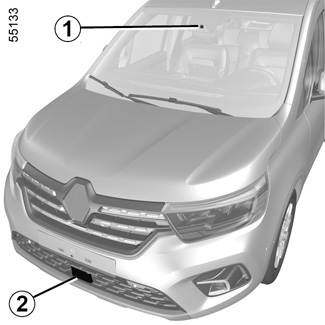
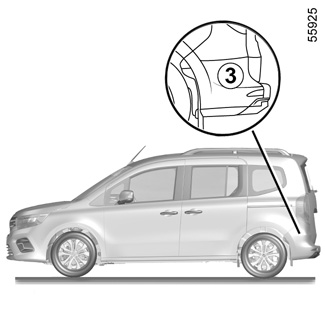
The “Advanced Security” system consists of:
- active emergency braking;
and
- Emergency Lane Keep Assist.
The “Advanced Safety” system uses information from the camera 1, front radar 2 and side radars 3.
Location of the camera 1
Make sure the windscreen is not obscured (by dirt, mud, snow, condensation etc.).
Location of the front radar 2
Ensure that the radar area is not obstructed (by dirt, mud, snow, a badly fitted front number plate), impacted, modified (including painting) or hidden by any accessory fitted on the front of the vehicle (on the grille or logo etc.).
Location of the side radars 3
Ensure that the radar area is not obstructed (by dirt, mud, snow etc.), impacted or modified (including paintwork etc.).
This system provides an additional driving aid.
This system is not, under any circumstances, intended to replace the due care and attention of the driver, who should at all times be in control of the vehicle.
Depending on the sensitivity setting selected, the “Lane Keep Assist” function may be used prior to operation of the “Advanced Safety” system.
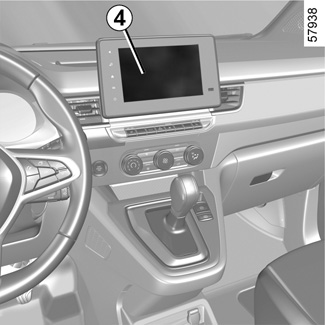
Activating, deactivating the system from the multimedia screen 4
(depending on the vehicle)
To activate or deactivate the function, refer to the multimedia instructions.
Select “ON” or “OFF”.

Activating, deactivating the system from the trip computer 5
- With the vehicle stopped, press the switch 6 as many times as required to reach the “Vehicle” tab;
- press the 7 or 8 control repeatedly to reach the “Settings” menu. Press the switch 9 OK;
- press the 7 or 8 control repeatedly to reach the “DRIVING ASSIST” menu. Press the switch 9 OK;
- press the 7 or 8 control repeatedly to reach the “Advanced Safety” menu and press 9 OK.
Press the switch 9 OK again to activate or deactivate the function:
= function activated
< function deactivated
Upon deactivation of the system, the warning light illuminates or, depending on the vehicle, the warning light illuminates in yellow on the instrument panel.
When the system is activated, the warning light disappears.
This system is reactivated each time the ignition is switched on.
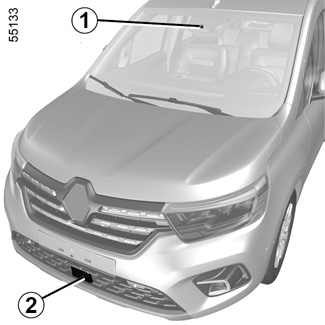
Active emergency braking
The system uses information from the radar 2 and the camera 1, to determine the distance from your vehicle:
- from the vehicle ahead in the same lane;
or
- from any oncoming vehicles in the context of a manoeuvre to change direction;
or
- surrounding pedestrians and cyclists.
The system informs the driver if there is a risk of head-on collision to enable appropriate emergency manoeuvres (pressing the brake pedal and/or turning the steering wheel).
Depending on the reactivity of the driver, the system can assist with braking in order to limit damage or prevent a collision.
This function is an additional driving aid.
This function is not under any circumstances intended to replace the due care and attention of the driver, who should at all times be in control of the vehicle.
This system can apply maximum braking to the vehicle until it is completely stationary if necessary.
For safety reasons, always wear your seat belt when travelling in your vehicle and make sure that it is loaded so that no items can be thrown forward and hit the occupants.

Active emergency braking
(continued)
Detection of vehicles
If driving at a speed over 5 mph (8 km/h) and there is a risk of collision with the vehicle in front, with an oncoming vehicle in the context of a manoeuvre to change direction, or with a stationary vehicle, the system:
- warns you of a collision risk:
the red warning light, or, depending on the vehicle, the display 10 and the message “Brake” appear on the instrument panel, accompanied by a beep.
If the driver presses the brake pedal and the system still detects a risk of collision, the braking force may be increased if it is not sufficient to prevent the collision.
- may trigger braking:
if the driver fails to react following the alert and collision becomes imminent.
If active emergency braking has caused the vehicle to stop, the vehicle is kept stationary for a short time. Beyond this time limit, the vehicle must be held stationary by the driver keeping their foot on the brake pedal.
Note: if the driver uses the vehicle controls (steering wheel, pedals, etc.) the system may delay certain operations or not activate.
In the event of emergency manoeuvre, you can stop braking at any moment by:
- tapping the accelerator pedal;
or
- turning the steering wheel as a collision avoidance manoeuvre.
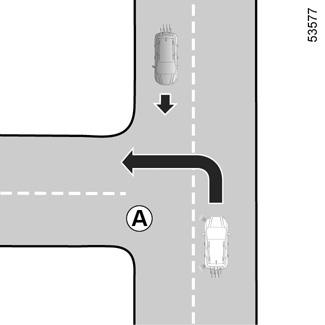
Active emergency braking
(continued)
Special features of oncoming vehicles in the context of a manoeuvre to change direction
When you wish to change direction (e.g. A), oncoming vehicles travelling at approximately 18 mph (30 km/h) to 35 mph (55 km/h) are detected by the system when:
- your vehicle is travelling at a speed between approximately 5 mph (8 km/h) to 12 mph (20 km/h);
- you have activated the direction indicator light.
The system is otherwise inactive and does not trigger an alert.
Special features of stationary vehicles
Stationary vehicles are detected when your vehicle is being driven at a speed between approximately 5 mph (8 km/h) and 62 mph (100 km/h). The system is not active and does not emit a warning for stationary vehicles when your vehicle speed exceeds approximately 62 mph (100 km/h).
Special features of warnings
Depending on the speed, the warning and braking may be activated simultaneously.
This function is an additional driving aid.
This function is not under any circumstances intended to replace the due care and attention of the driver, who should at all times be in control of the vehicle.
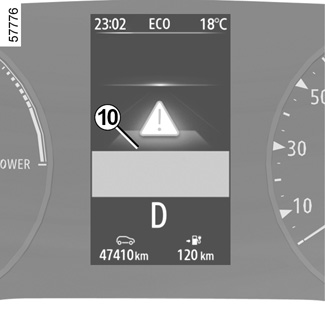
Active emergency braking
(continued)
Detection of pedestrians and cyclists
When driving at a speed between approximately 5 mph (8 km/h) and 53 mph (86 km/h), if there is a risk of collision with a cyclist or pedestrian, the system:
- warns you of a collision risk:
the red warning light, or, depending on the vehicle, the display 10 and the message “Brake” appear on the instrument panel, accompanied by a beep.
If the driver presses the brake pedal and the system still detects a risk of collision, the braking force may be increased if it is not sufficient to prevent the collision.
- may trigger braking:
if the driver fails to react following the alert and collision becomes imminent.
If active emergency braking has caused the vehicle to stop, the vehicle is kept stationary for a short time. Beyond this time limit, the vehicle must be held stationary by the driver keeping their foot on the brake pedal.
Note: if the driver uses the vehicle controls (steering wheel, pedals, etc.) the system may delay certain operations or not activate.
Special features related to stationary cyclists and pedestrians
The system does not detect stationary cyclists and pedestrians.
In this case, the system is inactive and does not trigger a warning.
In the event of emergency manoeuvre, you can stop braking at any moment by:
- tapping the accelerator pedal;
or
- turning the steering wheel as a collision avoidance manoeuvre.

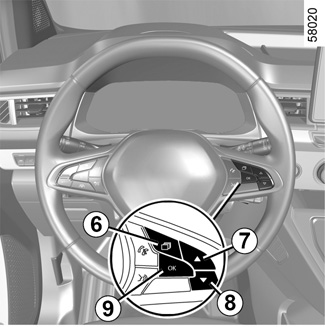
Active emergency braking
(continued)
Settings for vehicles equipped with a multimedia screen
To access the multimedia screen function settings 4, refer to the multimedia instructions:
- “Alert”: adjust the alert sensitivity level. To do this select:
- “At the latest”;
- “Standard”;
- “At the sooner”.
Please refer to the multimedia instructions for further information.
Settings for vehicles not equipped with a multimedia screen
- With the vehicle stopped, press the switch 6 as many times as required to reach the “Vehicle” tab;
- press the 7 or 8 control repeatedly to reach the “Settings” menu. Press the switch 9 OK;
- press control 7 or 8 repeatedly to reach the DRIVING ASSIST menu. Press the switch 8 OK;
- scroll repeatedly by pressing control 7 or 8 to reach the “Active braking sensitivity” menu. Press the switch 9 OK;
- press the 7 or 8 control repeatedly to adjust the setting. Press the 9 OK button.
Active emergency braking
(continued)
Temporarily not available
If the system detects a temporary fault the warning light illuminates, or depending on the vehicle, the warning light illuminates in yellow on the instrument panel.
The possible causes are:
- the system is temporarily blinded (glare from the sun, dipped beam headlights, bad weather conditions etc.). The system will be operational again when visibility conditions are better;
- the system is temporarily interrupted (e.g. the windscreen or the front or rear bumper is obscured by dirt, mud, snow, condensation, etc.). In this case, park the vehicle and switch off the engine. Clean the windscreen and front bumper. The next time the engine is started, after five or ten minutes of driving, the warning light and the message disappear.
If this is not the case, this may arise from another cause; contact an Approved Dealer.
Operating faults
When the function detects an operating fault, the warning lights © and or, depending on the vehicle, © and , appear in yellow on the instrument panel accompanied by the message “Check Front camera” or “Front radar to check” or “Check Camera/Radar”.
Consult an approved dealer.
Active emergency braking
This function is an additional driving aid. This function is not under any circumstances intended to replace the due care and attention of the driver, who should at all times be in control of the vehicle. The triggering of this function may be delayed or prevented when the system detects clear signs of control of the vehicle by the driver (action on the steering wheel, pedals etc.).
The system cannot be activated:
- if the gear control is in neutral position;
- when the parking brake has been activated for approximately ten seconds.
System servicing/repairs
- In the event of an impact, the radar and/or camera alignment may be changed and its operation may consequently be affected. Deactivate the function and consult an authorised dealer.
- Any work in the area where the radar and/or camera is located (repairs, replacements, windscreen modifications, etc.) must be carried out by a qualified professional.
Only an authorised dealer is qualified to service the system.
System disturbance
Some conditions can disturb or damage the operation of the system, such as:
- a complex environment (metal bridge, tunnel etc.);
- poor weather conditions (snow, hail, black ice etc.);
- poor visibility (night, fog etc.);
- poor contrast between the object (vehicle, pedestrian etc.) and the surrounding area (e.g. pedestrian dressed in white located in a snowy area etc.) ;
- being dazzled (glaring sun, lights of vehicles travelling in the opposite direction etc.);
- windscreen obscured (by dirt, ice, snow, condensation etc.);
- ...
In these conditions, the system may not react, may warn the driver or may brake inadvertently.
Limitation of the system operation
- Each time the vehicle is started, the system carries out a calibration according to the vehicle surroundings and may be inactive for a length of time between approximately two to five minutes of driving;
- An oncoming vehicle will not trigger any warning or system action if the conditions in the paragraph “Special features of oncoming vehicles in the context of a manoeuvre to change direction” are not met (see previous pages);
- The radar and camera zones must be kept clean and free of any tampering in order to ensure the proper operation of the system;
- the system may not respond to small vehicles such as motorbikes as effectively as to other vehicles;
- the system may not operate properly when the road surface is slippery (rain, snow, black ice, etc.);
- to ensure correct operation, the system needs to distinguish the complete outline of the pedestrian. So the system cannot detect:
- pedestrians in the darkness or in poor lighting conditions;
- partially visible pedestrians:
- pedestrians less than approximately 80 cm tall;
- pedestrians carrying large objects;
- ...
In these conditions, the system may not react or may brake inadvertently.
Deactivating the function
You must disable the function if:
- the area of the camera has been damaged (e.g. on the inside or outside of the windscreen);
- the front of the vehicle was damaged (impact, distortion, scratch on the radar etc.);
- the vehicle is being towed (breakdowns);
- the windscreen is cracked or distorted (do not carry out windscreen repairs in this area; have it changed by an approved dealer);
- you are not driving on a paved road.
In the event of the system behaving abnormally, deactivate it and consult an authorised dealer.
Halting the function
You can halt the active braking function at any time by tapping the accelerator pedal or by turning the steering wheel in a collision avoidance manoeuvre.
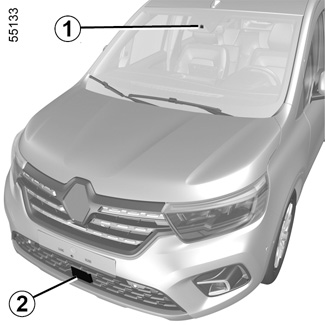
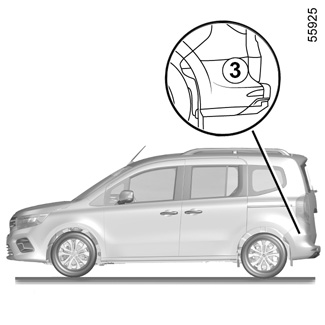
Emergency Lane Keep Assist
Using information from the camera 1, the function triggers corrective action on the vehicle steering system when approaching the roadside (divider, barrier, pavement, embankment etc.) without the direction indicator light having been activated.
Using information from the radar 2 and the camera 1, the function triggers corrective action on the vehicle steering system in the event of a risk of collision with a vehicle coming from the opposite direction in the adjacent lane, without the direction indicator having been activated.
Depending on the vehicle, using information from the radars 3 and the camera 1, the function triggers corrective action on the vehicle steering system in the event of a risk of collision with a vehicle moving at the same speed or at a higher speed, if within the detection area of the rear radars.
You can retake control of the vehicle at any time by operating the steering wheel.
This system provides an additional driving aid.
This system is not, under any circumstances, intended to replace the due care and attention of the driver, who should at all times be in control of the vehicle.
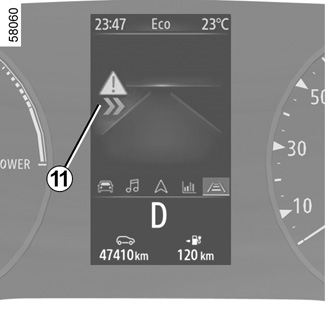
Emergency Lane Keep Assist
(continued)
Roadside detection
When driving at a speed over 43 mph (70 km/h), when approaching the roadside (on the ground, barrier, pavement, embankment, etc.), without the direction indicator having been activated, the system:
- warns you of a collision risk:
the warning light appears in red or, depending on the vehicle, the 11 display appears on the instrument panel accompanied by a beep;
and
- triggers corrective action on the steering system.
Special feature
In the event the function operates repeatedly when approaching the roadside, if the system does not detect any hands on the steering wheel, the warning lights appear in yellow on the instrument panel.
This function is an additional driving aid.
This function is not under any circumstances intended to replace the due care and attention of the driver, who should at all times be in control of the vehicle.
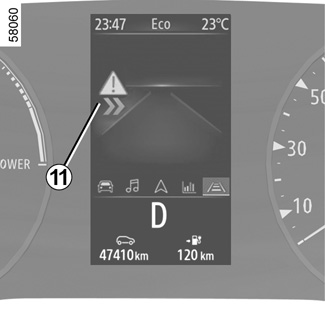
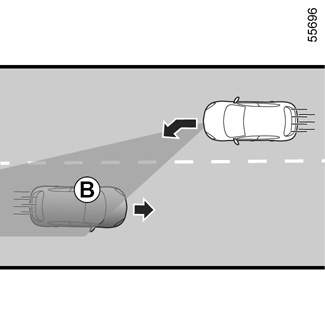
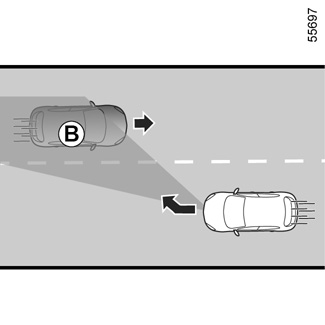
Emergency Lane Keep Assist
(continued)
Detection of an oncoming vehicle
When driving at a speed between approximately 43 mph (70 km/h) and 68 mph (110 km/h), if there is a risk of collision with a vehicle coming from the opposite direction in an adjacent lane and within the detection zone B, without the direction indicator having been activated, the system:
- warns you of a collision risk:
the warning light appears in red or, depending on the vehicle, the 11 display appears on the instrument panel accompanied by a beep;
and
- triggers corrective action on the steering system.
You can interrupt the trajectory correction at any time by moving the steering wheel.
This function is an additional driving aid.
This function is not under any circumstances intended to replace the due care and attention of the driver, who should at all times be in control of the vehicle.
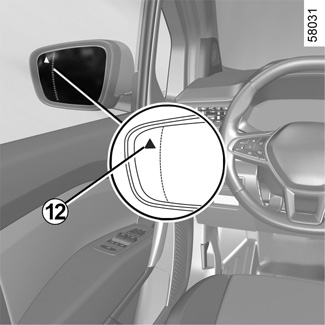
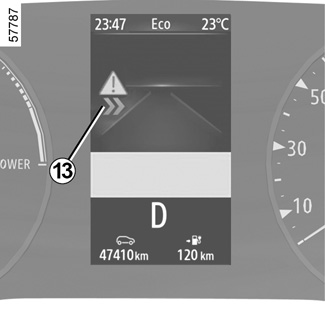

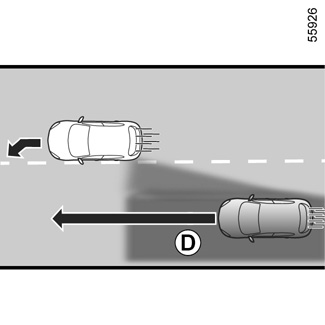
Emergency Lane Keep Assist
(continued)
Detection of a vehicle approaching from the rear
(depending on the vehicle)
While driving at a speed over 43 mph (70 km/h), if a line (continuous or broken) is crossed while there is a risk of collision with a vehicle located in the blind spot C and it is moving in the same direction as your vehicle or with a vehicle that is rapidly approaching from behind or in an adjacent lane that is in the detection area D, the system:
- warns you of the risk of collision: the warning light 12 flashes and the warning light appears in red, or, depending on the vehicle, the 13 display lights up on the instrument panel accompanied by a beep;
and
- triggers corrective action on the steering system.
Emergency Lane Keep Assist
(continued)
Temporarily not available:
- very fast lane departure;
- driving continuously on a line;
- approximately four seconds after changing lanes;
- tight bends;
- impaired visibility;
- activating the direction indicator light;
- strong acceleration;
- emergency braking;
- changing the lane width;
- operation of the active emergency braking system.
-...
Depending on the vehicle, if one of the side radars is obscured the message “Check Side radars” will appear on the instrument panel.
Conditions for non-activation of the system
The system cannot be activated when:
- reverse gear is engaged;
- the field of vision of the camera is obstructed;
- the front radar is obscured;
- the rear radars are obscured;
- the û warning light is displayed.
If one of the side radars is obscured, the warning light, or, depending on the vehicle, the warning light appears in yellow accompanied by the message “Side radars no visibility”. Clean the area where the sensors are located.
If the vehicle is equipped with a towbar that is recognised by the system, the warning light, or, depending on the vehicle, the warning light appears in yellow accompanied by the message “Trailer: side radars OFF” to inform you that the Emergency Lane Keep Assist is not operational.
If the vehicle is towing a trailer or caravan, unexpected or unnecessary corrections may occur. In this case you can deactivate the “Advanced Security” function to avoid unexpected or unnecessary corrections.
Operating faults
When the function detects an operating fault, the © and or, depending on the vehicle, the © and warning lights appear in yellow on the instrument panel accompanied by the message “Check Front camera” or “Front radar to check” or “Check Camera/Radar” or “Check Side radars”.
Consult an approved dealer.
This function is an additional driving aid. This function is not under any circumstances intended to replace the due care and attention of the driver, who should at all times be in control of the vehicle.
System servicing/repairs
- In the event of an impact, the alignment of the camera or radar(s) may be altered and its operation may consequently be affected. Deactivate the function and consult an authorised dealer.
- Any work in the area where the camera or radars are located (replacements, repairs, windscreen modifications etc.) must be carried out by a qualified professional.
Only an authorised dealer is qualified to service the system.
In the event of system disturbance
Some conditions can disturb or damage the operation of the system, such as:
- windscreen obscured (by dirt, ice, snow, condensation etc.);
- a complex environment (tunnel etc.);
- poor weather conditions (snow, rain, hail, black ice etc.) ;
- poor visibility (night, fog etc.);
- the road markings are irregular or difficult to distinguish (e.g. partially erased, excessive spacing, distorted road surface) ;
- being dazzled (glaring sun, lights of vehicles travelling in the opposite direction etc.);
- the road is narrow, winding or undulating (tight bends etc.);
- closely following a vehicle travelling in the same lane.
In this case, the “Advanced Safety” function may react incorrectly or not at all.
Risk of unwanted, incorrect correction or no correction of trajectory.
Deactivating the function
You must disable the function if:
- the camera area (on the windscreen side or the interior rear-view mirror side) or radar area(s) have been damaged;
- the windscreen is cracked or distorted (do not carry out windscreen repairs in this area; have it changed by an Authorised Dealer);
- the vehicle is being towed (breakdowns);
- you are not driving on a paved road.